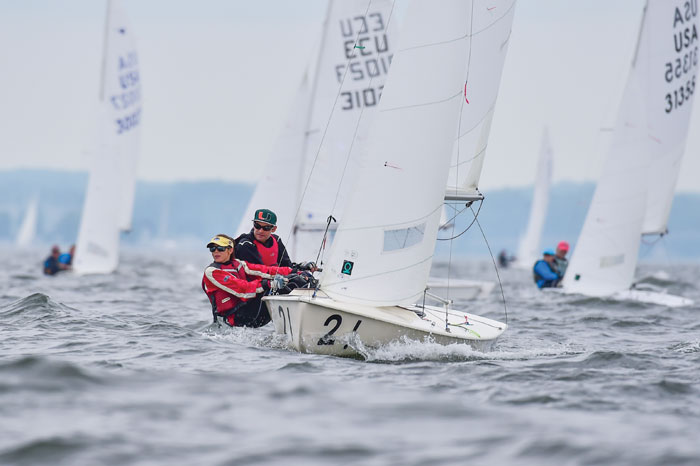“Wow, things do look different from here,” I thought, as I swiveled my head back to look at my Snipe skipper, from the “adventure land” crew position, “and they feel different, too.”

I had just been at a Laser Radial regatta, where it was me, myself, and I alone on a boat for seven days in a row. I ran out of jokes to tell myself early in the week and had to actually focus on sailing. The weekend after I got home, I was lucky enough to hop back in the front seat of a Snipe, where I have spent most of my recent sailing hours.
After the first race of the day, my skipper commented, “I can tell you have just spent a lot of time on a Laser.”
Hmm. Did that mean I was talking to myself more than usual? Nope. Her point was that I had a good strategic concept of the racecourse—likely stemming from having used my brain that way for a week of Lasering.
That got me to thinking. Skipper and crew positions can be such different experiences—and especially on doublehanded boats, skipper and crew rely on each other so much. It’s critical for each teammate to understand the other’s many roles and the stuff you both have to do and deal with. Here are some of the big differences, but remember, every kind of boat is different, so your experience may differ!
Skippers…
- Are ultimately responsible for not running into any other boats (or other stuff, for that matter).
- While racing, usually make the big-picture racecourse decisions (e.g. I want to stay on the lefthand side of the course).
- Often have very small and very big picture concepts of wind/weather on the racecourse: they track the wind that will hit them in the next five seconds because that’s where they’re immediately driving, but they can also generally move their bodies around more readily than a hard-hiking crew can to see wind across the racecourse.
- Get to feel how the boat feels, through the tug of the tiller (weather or leeward helm to help determine sail trim for better boat balance).
- Have a better view of whether the boat is flat or not.
Crews…
- Often have a better view sailing upwind of where some other boats are by looking through windows on the jib (e.g. keeping an eye out for starboard tackers).
- Upwind, often have a better view of the wind and waves in the immediate vicinity (arriving in the next 30 seconds or so) and can relay that along to skipper to better prepare them (“big waves in four boatlengths”).
- If they’re hiking hard, often crews can’t see the compass.
- Downwind, have a better view of all wind; they can see all the breeze headed down the race course: big, medium, and small picture.
- Have to rely on “butt feel” to determine whether the boat is flat, how it’s playing on waves and in puffs.
What each team member can contribute to boathandling, strategy based on weather and wave conditions, and tactics based on where other boats and the fleet are headed vary greatly. Knowing that you each know different stuff and feel different things can be a great motivator for better and more frequent communications.
How do you grow this knowledge? You’ve got to swap spots! Maybe let your crew drive in from the race course after racing. Set up a practice day where you spend about half the time in each other’s dinghy boots.
Even better, maybe you have a fleet that’s willing to work together to have a “crew race” at some point during a weekend, where everybody swaps spots. That gives crews the full experience of not only driving, but also thinking about race course management from a very different perspective. Be careful to do this at the right time, though: Many crews have gotten into sailing only through crewing, so actually driving a boat may be a big hurdle for them to get over. Choose the right weather conditions—nothing too windy or too light—to help them appreciate the feel of the helm without it being too intimidating.
Then, once you get back into your original seat, the greater understanding of what your skipper or crew does and has to deal with will make you a better teammate. So get out there and take a boat for a test drive… or a test crew!
by Kim Couranz




